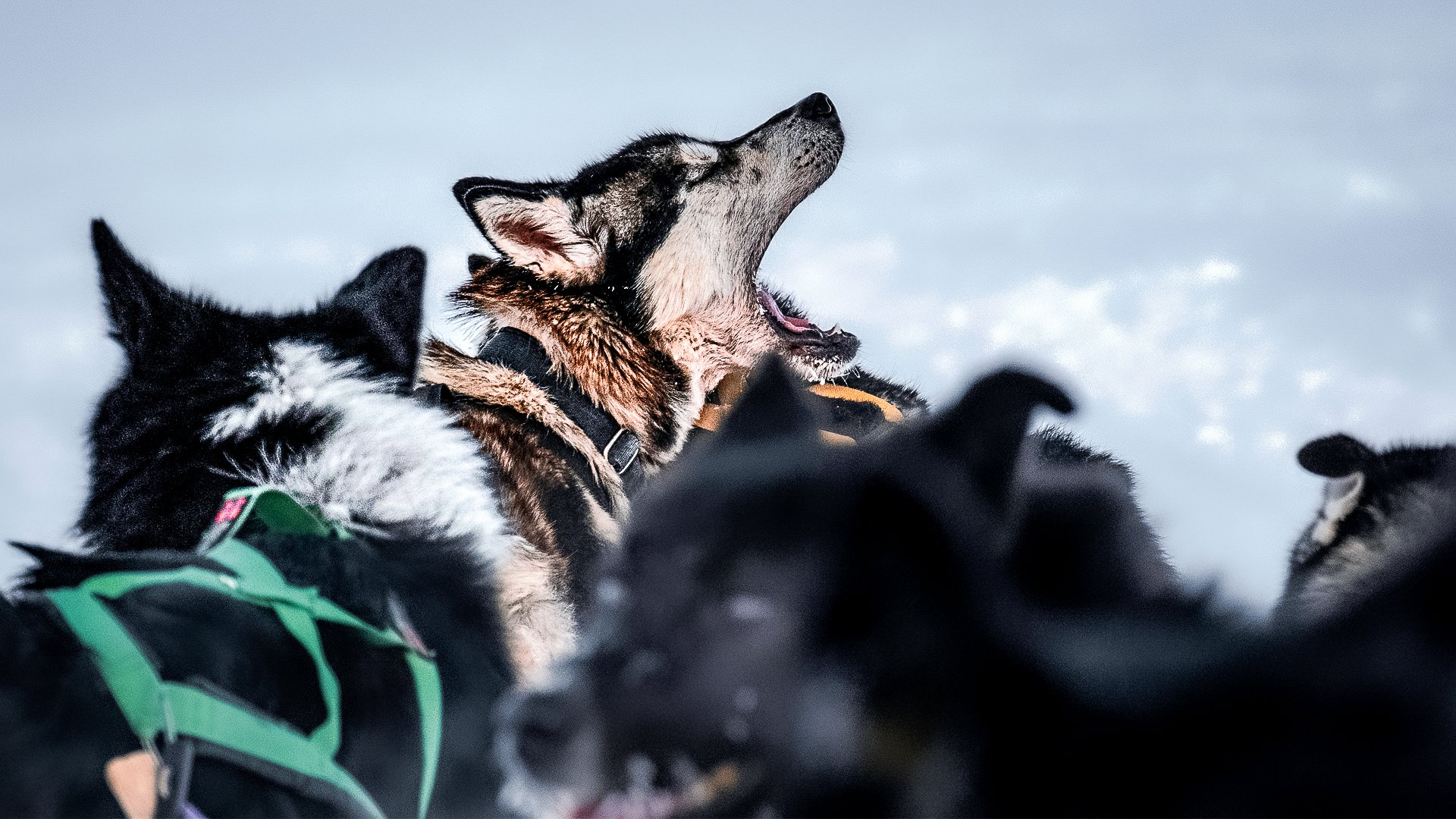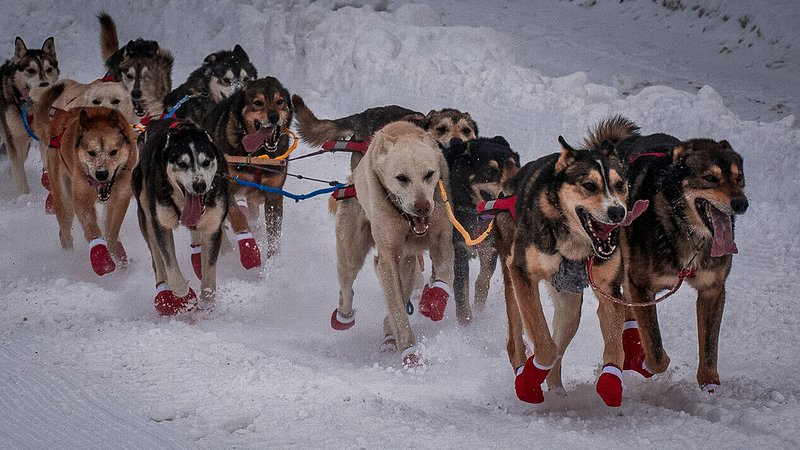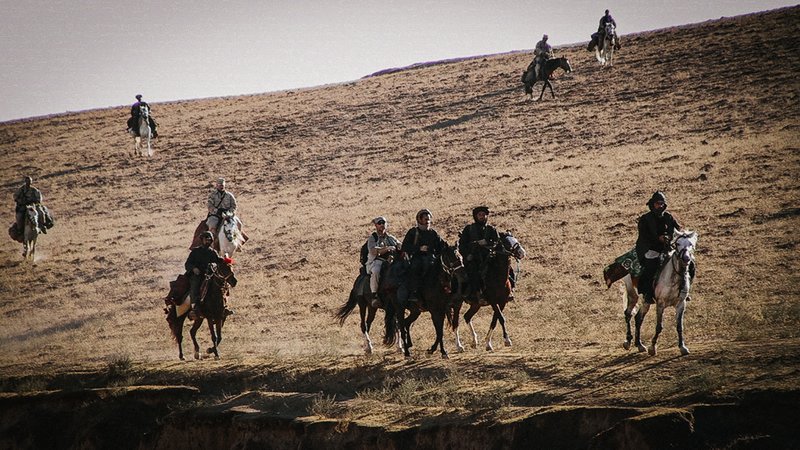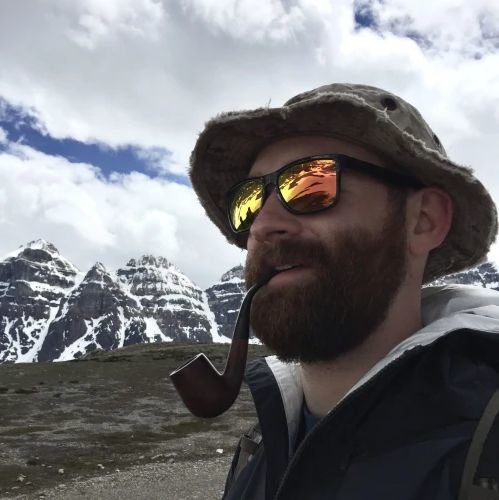This Alaska-Based Nonprofit Uses Dog-Sledding to Help Struggling Combat Vets

Humans have been mushing dogs for at least 8,000 years. Today, the ancient snow sport is helping veterans heal. Photo by Fredrik Solli Wandem, courtesy of Unsplash.
As a kid growing up in Upstate New York, Rick Casillo dreamed of becoming a Marine. His father and grandfather had both served in the Army, and military service was an important part of their identity. As soon as he was old enough to enlist, Casillo made a beeline to his local Marine Corps recruiting station. But the Corps turned him down, for medical reasons. Then, so did the Army, Navy, and Air Force.
Casillo’s dream was crushed, but in time he made peace with the reality that following in his father’s and grandfather’s footsteps would never be an option for him. There was no use in dwelling on what might have been. So he moved on, eventually making his way to Alaska, where he soon fell in love with the ancient sport of mushing. He was only in Alaska for three years before he competed in the Iditarod, the notoriously grueling 1,000-mile dog sled race through the state’s frozen backcountry.

Casillo now dedicates all of his time to helping combat veterans. Photo courtesy of Rick Casillo/Instagram.
Mushing became Casillo’s life. Since 2004, he has competed in the Iditarod 10 times. Yet his urge to serve his country never subsided. Though he couldn’t join the military himself, he still wanted to support those who did. In time, he figured out how. In 2014, he founded Battle Dawgs, a 501c3 nonprofit whose mission is to use one of the world’s toughest sports as a means to help combat veterans struggling with service-connected mental health issues, such as post traumatic stress or the lasting health impacts of traumatic brain injury.
Ultimately, Casillo’s instincts proved right: There is something about dog sledding that has a unique healing effect on the scars of war. US Army veteran Anthony Norris experienced it first hand. He was medically retired from the military in 2014, after being wounded by an IED in Afghanistan. As a civilian, Norris continued to struggle with his physical and mental injuries until he reached a point of hopelessness. Then, in 2016, he connected with Casillo and began mushing dogs in Alaska. Now, reflecting on the experience seven years later, Norris says it restored his appetite for life.

"The Last Great Race on Earth" throws 1,000 miles of Alaska’s jagged mountain ranges, frozen rivers, dense forests, desolate tundra and miles of windswept coast at the mushers and their dog teams as they set their eyes on the finish line in Nome, on the Bering Sea coast. US Air Force photo by Senior Airman Curt Beach.
“I have been shot, stabbed, and blown up, but none of that impacted my life as much as this experience,” he told Coffee or Die. “The Battle Dawgs team brought me in and gave my life a purpose again. They gave me a mission and the strength to complete it. I will forever be in their debt.”
A Faraway Place
Humans have been using canines to drive sleds for millennia, since sometime before 6000 BC. The practice began in Siberia as a method for transporting people and supplies across the Taiga and eventually spread across the Bering land bridge to North America where it was adopted by the natives. Many centuries later, in 1908, it became an official sport.
In professional sled racing, mushers drive a team of 12–16 dogs over vast distances. The courses typically wind through rugged, snow-covered landscapes that push both man and beast to their physical and mental limits. Provisions must be rationed, as they are limited to only what can fit on the sled. Traveling at an average of eight miles per hour, most races take days – or, in some cases, weeks – to complete.

An average of 1,000 dogs compete in the Iditarod each year. Photo by Ugar Arpaci, courtesy of Unsplash.
Races are categorized by distance. Anything under 100 miles is considered a “sprint.” Mid-range races can be as long as 300 miles. But the major competitions are all long-distance races, like the 1,000 mile Yukon Quest, and, of course, the Iditarod, the undisputed Super Bowl of mushing.
No one can say for sure where the name “iditarod” comes from. However, in 1979, James Kari, then a professor at the University of Alaska’s Native Language Center, surmised in a research paper that the name most likely stems from the Ingalik word “hidedhod,” which means “faraway place.”
The Iditarod National Historic Trail runs a diagonal course from Alaska’s southeast corner to the northwest coast. The annual race along the trail begins in Anchorage and ends 1,049 miles later in the city of Nome, just below the Arctic Circle. Mushers, typically competing with teams of 16 dogs, must brave blizzards, white outs, and temperatures that often plummet to -100 degrees fahrenheit. In the old days, the race usually took about 20 days to finish; today’s competitors average less than 10. While no musher has ever died during the race, every year the harsh conditions inevitably force some competitors to quit.
Once Casillo had mastered the sport of dog sledding, he became determined to help others experience the same sense of fulfillment it brought him. And he believed that a person grappling with the traumas of war stood to benefit from such an experience more than most. In mushing, he reasoned, a veteran might discover a common ground between the civilian he now is and the soldier he will always be.
“More people successfully climb Mount Everest than finish the Iditarod,” said Casillo. “It’s tough, and combat veterans know what it's like to take the mind and the body to a place where very few have gone.”

The Battle Dawgs camp sits on 650 aces of Alaskan wilderness. Photo courtesy of Rick Casillo/Instagram.
The program began small, with Casillo teaching one veteran the art of mushing at a time. Eventually, Casillo’s wife, Jennifer, herself an Army combat veteran with seven overseas deployments under her belt, encouraged him to take the leap and expand the program into what it is today.
Into the Wild
Now, twice a year, Casillo’s organization hosts a dozen veterans for a 10-day, all-expenses-paid retreat at their 650-acre camp in Talkeetna, Alaska. There is a mess hall on the property and each veteran gets a private cabin with a front row view of Mount Denali. Every morning, the group convenes in a 40-foot yurt, where Casillo briefs them on the day’s plans.
One of the annual retreats is held in the dead of winter, when Talkeenta is practically buried in snow. In addition to dog sledding, veterans who attend the winter sessions are taught ice fishing and snowmachining. For the mushing portion, the attendees are each assigned a team of huskies, with whom they will spend over a week bonding and training with before venturing out together into the unknown. On the final day of the retreat, every veteran embarks on a solo journey through the Talkeenta foothills.

Army Special Forces veterans of ODA 595, who famously rode horses into battle against the Taliban following the Sept. 11, 2001 terrorist attacks, are among the combat veterans who have attended Battle Dawgs. Photo courtesy of Wikimedia Commons.
Mushing is also a primary component of the summer retreats, though not to the same extent it is during winter. The huskies can’t run as long in warmer temperatures. But the lack of ice and snow means veterans can experience the Alaskan wilderness in other ways, such as through fly fishing. During the summer months, a stream that runs through the camp brims with salmon and trout waiting to be caught. Casillo also maintains a fleet of four-wheelers, which veterans are free to use to explore the 10 miles of backwoods trails that crisscross the property.
While the daily activities are different depending on the season, one aspect of the retreat remains constant: the veterans who attend spend a lot of time with dogs. The Battle Dawg camp is currently home to 65 of Alaskan huskies. Throughout their stay, veterans not only learn how to work with the dogs, but also how to care for them. This is an important part of the experience. In fact, according to Army combat veteran Matthew Berth, who attended in 2016, it is the dogs more than anything else that make the retreat so impactful.
“Like a lot of veterans, when I first came up here I felt very alone,” Berth is quoted saying in an interview published on Battle Dawgs’ website. “But as soon as you look into a dog’s eyes you know that dog will never hate you, never talk back to you, and will always love you. The dogs play a huge role in feeling loved and more alive.”
Read Next: Frozen Trident: A Navy SEAL’s Sled-Dog Operation on the Icy Edge of the Yukon

Mac Caltrider is a senior staff writer for Coffee or Die Magazine. He served in the US Marine Corps and is a former police officer. Caltrider earned his bachelor’s degree in history and now reads anything he can get his hands on. He is also the creator of Pipes & Pages, a site intended to increase readership among enlisted troops. Caltrider spends most of his time reading, writing, and waging a one-man war against premature hair loss.
BRCC and Bad Moon Print Press team up for an exclusive, limited-edition T-shirt design!
BRCC partners with Team Room Design for an exclusive T-shirt release!
Thirty Seconds Out has partnered with BRCC for an exclusive shirt design invoking the God of Winter.
Lucas O'Hara of Grizzly Forge has teamed up with BRCC for a badass, exclusive Shirt Club T-shirt design featuring his most popular knife and tiomahawk.
Coffee or Die sits down with one of the graphic designers behind Black Rifle Coffee's signature look and vibe.
Biden will award the Medal of Honor to a Vietnam War Army helicopter pilot who risked his life to save a reconnaissance team from almost certain death.
Ever wonder how much Jack Mandaville would f*ck sh*t up if he went back in time? The American Revolution didn't even see him coming.
A nearly 200-year-old West Point time capsule that at first appeared to yield little more than dust contains hidden treasure, the US Military Academy said.












